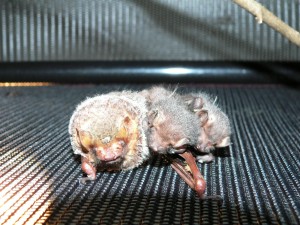
These young Seminole bat pups were separated from their mother and extremely vulnerable in the wild. The local Wildlife Sanctuary nursed them to health. Photo credit: Carrie Stevenson
![]() As spring commences and young wildlife of all species are born, everyone’s favorite flying, furry mammal begins roosting season. Ideally, bats will find homes in trees, caves, abandoned buildings, and bat houses, but sometimes they end up in a home. I receive calls often about how to best remove or exclude a group of bats living in an attic or garage. While there are countless benefits (most notably, efficient insect control) to having bats in one’s landscape or neighborhood, most people prefer they not share their own home with them.
As spring commences and young wildlife of all species are born, everyone’s favorite flying, furry mammal begins roosting season. Ideally, bats will find homes in trees, caves, abandoned buildings, and bat houses, but sometimes they end up in a home. I receive calls often about how to best remove or exclude a group of bats living in an attic or garage. While there are countless benefits (most notably, efficient insect control) to having bats in one’s landscape or neighborhood, most people prefer they not share their own home with them.
Bats have a slow reproductive cycle and declining populations in the United States, and are protected by several state laws. According to Florida Administrative Code 68A-9.010 under “Taking Nuisance Wildlife,” it is illegal in Florida to prevent bats from returning to any roosting location from April 16 to August 14. Female bats typically give birth during maternity season to one pup (or rarely, 2-3), which clings to the mother’s fur to nurse for their first few weeks and months of life. Being nocturnal, this means mothers and babies will be inside a dwelling during the day. Typically, if a homeowner is trying to exclude bats from a home, they will put up netting or seal a hole in an attic entry in the evening after bats have flown off to feed on insects at night. However, if this is done during roosting season, young bats left back in the roost while mothers are hunting can get trapped inside a building and will not survive.
This obviously has the potential to cause conflict between homeowners and the bat population. The Florida Fish & Wildlife Conservation Commission has regulatory oversight for bat-related issues, and they will work with citizens to arrange a positive outcome for both the property owner and the animals involved. Bats play an important role the ecosystem as efficient controllers of insect populations.
Unfortunately, bat populations are declining in North America due to a devastating disease called white-nose syndrome and loss of habitat. However, you can help these fascinating animals by installing a bat house in your yard. Keep in mind that bats attracted to bat houses prefer to be in open areas away from trees (where their predators hide), and the house should be installed at least 12 feet in the air. Bat houses can be purchased or built rather simply—keep an eye out for Extension workshops near you, or visit the UF Wildlife Ecology publication, “Effective Bat Houses for Florida” or Bat Conservation International’s website for simple instructions.
To learn more about bats and how to help them, visit this website or contact me or your local County Extension office!
- Crane Flies - April 18, 2024
- Rosemary - March 7, 2024
- The Franklin Tree - January 18, 2024
